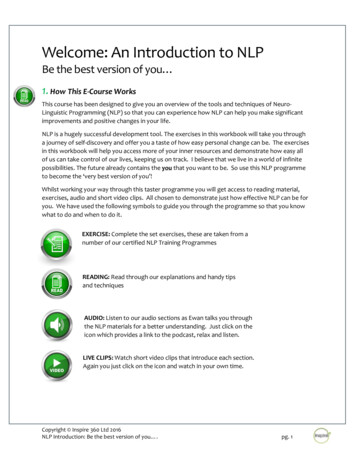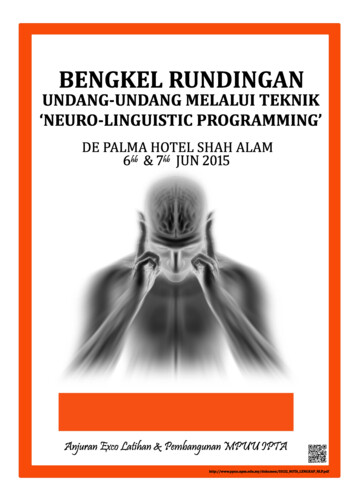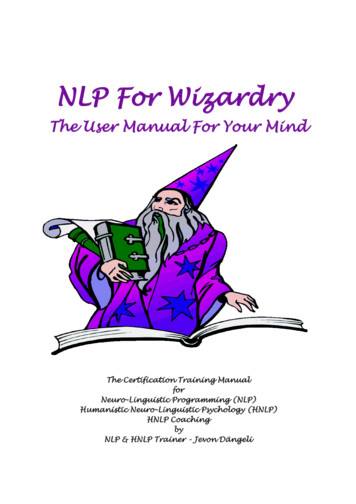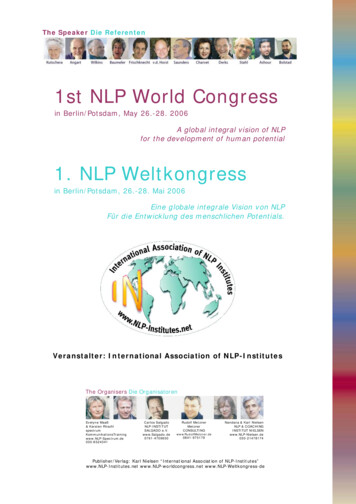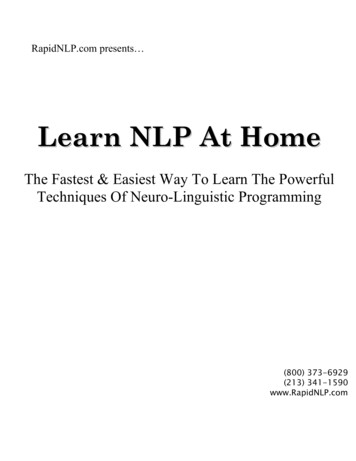
Transcription
NLP Trainer’s Training
NLP TRAINERS TRAININGIntroduction and OverviewnotesThis manual was designed to assist Certified NLP Trainers to deliver NLPPractitioner Certification courses. It outlines the attitudes, skills, format,and techniques that have been successfully employed by the iNLP Center while delivering NLP courses over time.While this manual gives clear ideas about what has worked, it is not initself complete. This manual was designed to be used as a helpful companion to the NLP Practitioner Certification Manual.This manual does not have to be rigidly followed. An NLP Training is awonderful journey over a period of time. Every training takes a slightlydifferent course. Above all, the trainer should be aware of the specificneeds of the group and be flexible in addressing those needs. iNLP Center 2015
NLP TRAINERS TRAININGTrainer’s PyramidnotesThe Trainer’s Pyramid represents the priorities of an effective NLP trainer.Self- management, at the top of the pyramid is the most important aspect of conducting a successful NLP training, followed by certain indispensable core competencies the trainer must utilize. With properself-management and the basic core competencies in place, the traineris ready to utilize the NLP training format to teach the major and minortechniques.All levels of the Trainer’s Pyramid are essential to the delivery of the training. It is interesting, however to examine the order of priority that isnecessary for the training to work well.On the surface, it would seem that the NLP techniques being taughtwould be the top priority. Imagine, however, that those techniques arebeing taught by a trainer who is preoccupied with himself, inattentiveto questions, or harsh with the students. It doesn’t take long to realizethat no matter the content being taught, the character or state of beingof the trainer determines the degree to which the training content iswell received.Moreover, imagine that the trainer exercises good character, but is unable to make the students feel at home in the training room (build community), does not know how to break teaching pieces down intomanageable pieces, lectures extensively (in an experiential training environment), and does not model for the class what he is teaching. It isobvious in this setting that an NLP training would be ineffective. Without certain core competencies beyond quality character and the trainingcontent, the trainer will fail.Now imagine the following training scenario: The trainer exemplifiesquality character. She is open, respectful, clear, and congruent with the iNLP Center 2015
NLP TRAINERS TRAININGmaterial she is teaching. She is comfortable with herself and thereforeis able to address the student’s questions and concerns in a way thatmakes them feel comfortable and respected.notesThe trainer is able to break down the teaching material into easily assimilated pieces. She fosters as sense of community among the students, so that they feel a bond one to another. She models in herbehavior and communication the skills she is teaching, so that the students can learn by observing her. She is able to help the students personally manage themselves through the course of ten days of intensepersonal learning and growth. It is not hard to imagine that this is thetrainer who can successfully conduct an NLP training.Beyond self-management and core competencies it is necessary to havea productive format in which to teach NLP. Since NLP can only belearned by experience, the teaching structure allows the students tobegin the experiential process as soon as possible.Finally, there is power in the techniques. Given all of the above, the students will discover resources within themselves which they simply didnot know existed. Through the NLP basic skills and models, the studentswill have unique experiences of personal growth and awareness, andleave a different person than what they were when they arrived at thetraining. iNLP Center 2015
NLP TRAINERS TRAININGSection 1: Self-ManagementnotesThere are several elements of self-management for the NLP Trainer.They include: Adequate rest: The trainer needs to be well rested and fresh whendelivering an NLP course. We recommend that you take two days offbefore a training weekend and one day off after. Preparation: In the early stages of being an NLP Trainer, we suggest1/2 day of preparation for every day of training. This will allow you tobe very thorough in your preparation. Breath Control/Pacing: Slow, monitored breathing sets a tone of relaxation for the training. Most of the students will probably be anxious.Relaxed breathing on the part of the trainer will establish a pace for thestudents to follow. Being a Host: Part of the Trainer’s responsibility is to make the studentsfeel well attended. Providing snacks, beverages, and a comfortabletraining environment is a part of that responsibility. Sensory Acuity: The essential element in discovering whether or notthe training is working! The appropriate sensory acuity stretches beyondthe bounds of what the trainer intends (presupposition #2) to communicate to what message is received by the class. An astute trainer willnot be concerned so much with what is supposed to work, but what isactually effective based on observation.Flexibility: Noticing the class response to your communication is pointless without the ability to adapt the training appropriately. Perhaps youwill need to spend more time on certain elements of the training. Perhaps you will need to move on to other material in spite of the fact thatsome members of your class do not understand the present material.Perhaps you will have to bring in material that is not part of your previous plan. All of this requires judgment and flexibility on your part.Congruence: Have you had a profound experience with the materialyou are teaching? Has it changed your life in some way? Can you tellan inspiring story about how a particular technique has shaped your understanding? The more you can do so the more congruent your message will be. iNLP Center 2015
NLP TRAINERS TRAININGMaintaining Boundaries: Remember quality, not quantity when it comesto your relationship to the students. Answer all questions in personalized and thoughtful way without extending the conversation. Give yourundivided attention in a way that is limited by time. Students need tofeel well attended to but not allowed to feel they can engage in trivialconversation with the trainer.notesPostpone questions to more advanced training where appropriate.Out of class casual relationships between trainer and student are notappropriate.The trainer should also see that the students treat each other with theutmost respect and regard. iNLP Center 2015
NLP TRAINERS TRAININGSection 2: Core CompetenciesnotesAll of the core competencies reflect methods for creating a successfulNLP training. Additionally, it is at times helpful to consider Chunkingand Association/Dissociation as useful in troubleshooting problems thatarise in the training.ChunkingThe trainer needs to be aware of multiple levels of chunk size in the activity ongoing in the training. Here are some of them: Individual students: are they choosing small enough chunk sizes towork with during the small group exercises? The group: are they on board or confused? Are they too caught upin the details that it prevents them from grasping the purpose of theteaching? Is their energy level high or low? The training: is the training on course, according to the training syllabus? Is the trainer spending time on issues that do not reflect the present training purpose?Ability to Associate or Dissociate StudentsHere is a general principle to follow with students: Associate the students who aren’t taking the training seriously. Dissociate the students who are taking it too seriously.Some behaviors which may reflect a student who is not taking the training seriously are: avoiding others, joking around too much, tardiness,lack of effort in doing the exercises.Behaviors which may reflect a student who is taking the training too seriously include: self-criticism, asking too many questions, tense physiology, anxiety when being the Programmer.These are not exhaustive lists. What are others you can think of? iNLP Center 2015
NLP TRAINERS TRAININGnotesWays to associate students: Confront them on poor behavior. Acknowledge their tendency to not take the training seriously. Use the group to place them on the spot.Ways to dissociate students: Use the “simple frame”. Ask them to use their Meta Person. Tell them it’s ok to us their manual during exercises. Remind them this is just practice.ModelingWhatever you are teaching, be doing that all them time. This is theframe when teaching any NLP skill. If you are teaching submodalitiesand a student asks if it is relevant to help him with a problem with acoworker, ask if he sees and hears the coworker on the right, left, ormiddle. Simply begin eliciting the submodalities of the issue the studentis presenting and working with them. For example:So, your coworker is on the left, small, and distant. These are the submodalities of someone you feel alienated from. What happens if youmove the image a little closer and make it a little brighter?Once a shift for the student has occurred, then the trainer and the student can point out how the shift in submodalities affected the issue withthe coworker. This is a much more sophisticated way of answering thequestion.Look for opportunities to model every aspect of the training.Modeling is the foundation of live work.Create a CommunityCommunity is the bond between class members that results from positive interaction among themselves over a period of time. Here are somethings to remember to foster a strong bond between class members: iNLP Center 2015
NLP TRAINERS TRAINING Games and activities, they need to be done right so people feel included. If you do the games wrongly, people feel left out.notes Keep the training experiential. Avoid lengthy discussion in class byreinforcing the idea that most of their questions will be answered as aresult of the small group exercise. Use open frames for theory discussion. Make the training a safe place for everyone. The warmth, humorand good nature of the trainer help accomplish this.If a sense of community has not developed by the fifth day of the training, developing one should be the highest priority of the trainer. Howwould you accomplish that? iNLP Center 2015
NLP TRAINERS TRAININGSection 3: NLP Training FormatnotesThe NLP Training Format is used when teaching all the NLP techniquesin the training. It is a process which consists of five stages: introductionto the technique/model, demonstration, questions about the demonstration, small group exercises, and general questions/comments.INTRO TOTECHNIQUE/MODEL STAGE 1DEMOSTAGE 2 DEMOQUESTIONSSTAGE 3 EXERCISESSTAGE 4 GENERALQUESTIONSSTAGE 5STAGE 1Introduction to the Technique or ModelThis time is used to give the students a brief overview of the techniqueor model, explain what it is used for, and establish the interest of thestudents in learning it. It is this interest that will motivate some studentsto volunteer to be demonstration subjects. Typically the introduction to any model or technique is relativelyshort, as we rely on the experience of the process to educate the students more than lecture. The introductory remarks should reflect the trainer’s clarity on andenthusiasm for the technique. For the most part students will rely onthe trainer’s state to motivate them to experience the technique forthemselves. The more personal the trainer is in relating the introduction to herself,the more interest the students may take.STAGE 2DemonstrationThe demonstration is the student’s opportunity to observe an expert do iNLP Center 2015
NLP TRAINERS TRAININGwhat they will be asked to do. It provides an opportunity for the trainerto model his expertise.notesThere are three elements of an effective demonstration; choosing an appropriate demonstration volunteer, dividing the attention between thevolunteer and the class, and balancing the teaching and therapeutic aspects of the demonstration. All of theses elements are dependent uponthe trainer’s sensory acuity.Here are some tips on choosing a demonstration subject: Choose someone you like, and whose personality you are comfortable with. There is no need making the more complicated than it needsto be. Never choose a polarity responder as a demonstration subject. Likewise, do not choose anyone who has not personally bought in to thetraining. Ask for several volunteers to name the problem they want to addressas a volunteer. Don’t commit to working with anyone until you haveheard all the volunteers, then choose the one you are most comfortablewith. A good idea is to use your sensory acuity to determine which volunteer seems most congruent about wanting a change and working infront of the group. Choose people who are, in general, responsible and resourceful.Then, even if the demonstration turns out to be difficult, you can trustthat the volunteer will manage herself.Here are some thoughts about dividing attention between the demonstration volunteer and the class:When doing a demonstration of NLP techniques for the class, a divisionof attention between the class and the client is necessary. As a generalrule, the client should get the majority of the attention. The trainer canupdate the class on where she is at in the process during times whenthe client needs to process some information internally or is stuck. Inthese instances taking the attention off the client can relieve some pressure, and give the trainer opportunity to give the client indirect suggestion.For example:We are on step four of the Six Step Reframe. John (client) is now ac iNLP Center 2015
NLP TRAINERS TRAININGcessing his creative part to generate new behaviors. We have identifiedthe part that makes him do behavior X, and discovered that the positiveintention of behavior X is for him to protect himself. Protecting ourselves is very important, and now John is generating new ways to protect himself. This doesn’t mean he has to give up behavior X, it meanshe will become better at protecting himself as he gains more choices.notesThis kind of language is frequently irresistible to the demonstration volunteer. He knows he is not being spoken to directly, but hears and responds to every word nonetheless. Often when the trainer turns hisattention back to the demonstration volunteer after such remarks, theinstructions have been carried out.Balancing the teaching and therapeutic aspects of the technique beingdemonstrated:While doing a demonstration, two things are happening. One, the volunteer is receiving a therapeutic technique. Two, the class is beingtaught. A balance between the two of these outcomes is necessary. Thegeneral rule of thumb is to remember that in the Practitioner Certification Training, the principal outcome is learning and practicing the techniques. Most often, meaningful therapeutic gains are the result of suchlearning and practicing. However, if a trainer must choose betweendoing therapy with the volunteer and teaching the skill, teaching theskill takes priority.STAGE 3Questions About the DemonstrationAfter the demonstration is complete, the trainer invites questions fromthe class specifically about the demonstration and how to perform thetechnique. This is not the time for theoretical questions or comments.The purpose of this time is to further prepare the class to do the technique with each other in the small group exercises. All other questionsshould be diverted until after the exercise.The question the trainer asks himself during this period is, “Will the answer to this student’s question help him perform the technique moreeffectively?” If so, answer the student’s question. If not, ask the studentto save the question until after the exercise. iNLP Center 2015
NLP TRAINERS TRAININGSTAGE 4Small Group ExercisesnotesAs the class participates in the small group exercise, the trainer shouldbe generally available to students for help. There are five things towatch for and correct if necessary: Are they using their Meta Person for help?Get in the habit early of using the Meta Person as the first option whenthe Programmer needs help. This way the Meta Person will be challenged to learn the technique from a dissociated position. Relying onthe Meta Person will also foster teamwork and a sense of community.If the trainer notices that certain individuals are not utilizing their MetaPersons, those individuals can be reminded to do so in private. Or, ifthis is a pattern in the class, the class can be further instructed aboutthe role of the Meta Person and reminded to use her. Are they using their manual for help?It helps some students to know that they can turn to their manual forhelp as they are doing interventions with clients. Knowing this the Programmer can slow her pace down and concentrate on completing onestep at a time. This process may ease some performance anxiety. Has the client chosen an appropriate chunk size problem for the technique being practiced?This question represents a fundamental concern the trainer needs tohave throughout the practitioner training. Here are some signs that theClient has chose too large a chunk to work on. The Client is overwhelmed emotionally. The Programmer is overwhelmed. The technique is producing no positive outcome and the client hasa hard time completing the steps as directed by the programmer. Ecology concerns keep coming up. Is there rapport between the Programmer and Client?It is not uncommon that students will end up working in small groupsamong people with whom they have personality differences. The trainerneeds to monitor this and use her judgment in monitoring such groups.Upon the request of the student the trainer should allow the student toswitch groups. iNLP Center 2015
NLP TRAINERS TRAININGThe trainer should intervene without being asked only in extreme situations in the groups, such as a verbal altercation between the students.In most situations, if the students are not asking to switch groups, thetrainer should leave them to establish some working rapport on theirown. The trainer can coach any student regarding this matter on a individual basis.notes Does the energy level in the room reflect the student’s interest inthe technique?If there is low energy in the room it usually means the students are notengaged with the teaching material. Here are some reasons why thismay be the case: The students are confused and need further instruction in theteaching content. The students are tired and need a break as soon as possible. The students are finishing their rounds and are running out ofthings to do.In any such case the trainer should act immediately to remedy the situation by further clarifying, suggesting a break, or calling the studentback to the large group.STAGE 5General Questions/Comments about the Technique or ModelAfter the small group exercise the trainer has the opportunity to closethe teaching piece with the class. The trainer’s outcomes in doing thisare as follows: Answer any further questions about the technique itself, it’s purposeand sequence of steps. Invite and encourage any comments from the class as to their experience in small group. This is critical to the success of building a community among the students. Many times students share freely in smallgroups but are reluctant to share their experience with the class as awhole. The trainer can take individuals aside who have positive experiences during the small groups and encourage them to share their experience with the class. Take opportunity to model the technique or concept further for the iNLP Center 2015
NLP TRAINERS TRAININGclass.notes Focus on application or integration of the teaching into their livesoutside the training. Ask the students to identify where and when therelevant model is applicable in their present relationships and situation. iNLP Center 2015
NLP TRAINERS TRAININGSegment Four : Training Content/NLP TechniquesnotesIntroduction to NLPTrainer’s Perspective:In one sense this entire training is an introduction to NLP. It takes atleast ten days to begin to understand what NLP is and how it appliesto individual situations. Let this fact take some pressure off your formal introduction. The formal introduction can be short and sweet, asa lead into some experiential exercises.Training Purpose:To introduce students to NLP.Steps:1. Introduction to the Technique/Model: On your own.2. Demonstration: On your own.3. Questions about the Demonstration: On your own.4. Small Group Exercises: On your own.5. General Questions/Comments: On your own.Introduction to VAKTrainer’s Perspective:The VAK model is one of the fundamental models of NLP. It affectsevery aspect of our experience. Students will have a significant opportunity here to expand their self-awareness by learning this deeplyunconscious aspect of human experience.Training Purpose:To introduce students to the model that our communicating experiences are comprised of the three main modalities; visual, auditory,and kinesthetic. This introduction is to prepare the students learn theEye Accessing Cues chart with it’s corresponding exercises, and tolearn VAK Process Words.Introduction to the Technique/Model:Introduce this model with an explanation that for the purpose of communication, most of our experience falls into three modalities; visual,auditory, and kinesthetic. Point out that once we learn to recognize iNLP Center 2015
NLP TRAINERS TRAININGhow our communication patterns fit into the modalities, we can learnto recognize communication breakdowns and correct them more effectively.notesDemonstration:An effective story would demonstrate how mismatching modalitieslends to misunderstanding in relationships.Example:A couple goes to see their therapist, each complaining that the otheris unloving. The conversation goes like this:John: My wife doesn’t appreciate my love for her. When I hug her orwant to be close to her she stiffens up and reacts in a cold manner.Mary: What do you mean? I tell you I love you all the time. But whenwas the last time you said those words to me?John: Words are cheap. Anyone can say I love you and not mean it.How about a hug to make me feel close to you now and again?Mary: All I want is for him to talk of his love for me, and here he iswanting to smother me by hanging all over me.Therapist: It looks to me like the two of you do not know how to showeach other your love. Let’s see what we can do to help you.!Make the VAK incongruities obvious enough for the students to pickup on them. Use spatial anchors to segregate the conversation between John and Mary. Keep the demonstration going until everyonein the class understands what is going on. This will help the class understand the implications of the VAK Model.Questions about the Demonstration:Remember to field questions only to clarify what was going on in thedemonstration story.Small Group Exercises: N/AGeneral Questions/Comments:Does all our communication fall into the three modalities?Most of it does. Rarely do we communicate with reference to tasteand smell. The majority of our experience relates to what we can see, iNLP Center 2015
NLP TRAINERS TRAININGhear, and feel. Even when we use neutral words like “understand” weare at a deeper level assimilating our experience of things we haveseen, heard, or felt.notesVAK Process WordsTrainer’s Perspective:By now the students have a working understanding of the VAK model.Notice how the sense of community is developing in the group asthey practice this exercise.Training Purpose:Process words and the group story exercise are designed to expandVAK awareness and build skill and flexibility in using this model conversationally.Introduction to the Technique/Model:Explain that you will be doing a fun exercise to help increase and integrate awareness of the VAK model. Refer them to the process wordslist in their manuals and explain that these words indicate preferenceto specific VAK modalities.Demonstration:Call up three volunteers to help you demonstrate how the techniqueis done.Questions about the Demonstration:Process questions only.Small Group Exercises:Groups of four or five are necessary. Allow the students to relax andgo at their own pace with this one. It is designed to be fun and nontechnical in nature. Be careful not to let the exercise drag on past thepoint where the begin to find it laborious.General Questions/Comments iNLP Center 2015
NLP TRAINERS TRAININGEye Accessing Cues ChartnotesTrainer’s Perspective:The NLP Eye Accessing Cues is one of the more interesting claims NLPmakes about communication. No other model recognizes the distinctions that NLP makes about eye movement patterns.Training Purpose:To familiarize students with the Eye Accessing Cues chart as well as integrate knowledge and self-awareness of the VAK Model.Introduction to the Technique/Model:Introduce the Assessing Cues chart first by explaining how our eyemovements correspond to internal patterns of accessing information.Remember to explain that the chart refers to 90% of people. Theother 10% are what we call reversed. Reversed simply means you arephysiologically organized differently (usually the opposite horizontallyof the chart). It does not imply any defect. Some people are simplyorganized differently, we don’t know why.Demonstration:The trainer should be able to demonstrate this to the class using howown eye movements. Give plenty of examples asking the class to payattention to the eyes:If you ask me the color of my first bicycle, (moving eyes to Vr) myeyes would have to search for that information.If you ask me what a good back massage feels like, my eyes wouldsearch in a different place for that information (moving eyes to K).If you ask me to imagine the sound of rain falling on a pillow (eyes toAc) I might have to imagine that by moving my eyes this way.Questions about the Demonstration:Make sure the class knows the chart intellectually and take questionsonly about the chart itself. Avoid any discussion about theory or applicability at this point. It is more important to get them to have anexperience with this before questioning it. iNLP Center 2015
NLP TRAINERS TRAININGSmall Group Exercises: N/AnotesGeneral Questions/Comments:Avoid general questions at this point. We are only explaining the eyechart so that the class can move on to the exercise.Eye Accessing Cues: Exercise OneTraining Purpose:To learn the Eye Accessing Cues through observation of eye movement patterns.Introduction to the Technique/Model:Explain that this exercise is simply asking questions designed to elicitcertain response in the client, and observing those responses in orderto familiarize ourselves with the Eye Accessing Cues chart. Refer tothe Eye Accessing Cues Chart while explaining the process.Demonstration:You may call two students to the front of the room to use as a demonstration of how the exercise works.Questions about the Demonstration:Only take questions about how to do the exercise. Make sure that thestudents understand the structure of the questions on the chart. Ifthey are able, they can make up their own questions to elicit eyemovements in their partners.Be sure to remind them to have the question in mind before asking it.If they reading the question, they may miss the eye movement of theirpartner.Small Group Exercises:Diads. 10 minutes per round, including feedback between the partners. iNLP Center 2015
NLP TRAINERS TRAININGGeneral Questions/Comments:notesIs this model scientifically proven?No. This model was created by observation only.My partner’s eyes didn't move according to the chart. What does thismean?Your partner may be reversed, so you may want to check for that. It isalso helpful to ask your partner what her internal experience is when responding to the questions. For example, If you ask me how I felt on mylast birthday, I may access an image of the birthday party before I canknow how I feel. This will give visual cues instead of kinesthetic.Eye Accessing Cues: Story Telling ExerciseTraining Purpose:Further observation of accessing cues in a less structured setting aswell as an opportunity for the client to learn which is her primarymodality.Introduction to the Technique/Model:Explain that this next exercise is to give further experience with eyeaccessing cues and to begin to learn each student’s preferred modality.Demonstration:It is OK to invite students up to the front of the class to demonstratehow to do the exercise.Explain that as one student is telling her story, the job of the other isto track the eye movements and determine the preferred modality.This can be done by observing where the student’s eyes move mostoften.A key outcome is to stay in structure - not to get associated with thestory to the point of missing the eye movements.Questions about the Demonstration:Take questions only about how to do the exercise. iNLP Center 2015
NLP TRAINERS TRAININGSmall Group Exercises:Same Diads as previous exercise. 10 minute rounds, including feedback.notesGeneral Questions/Comments:After the exercise check to see if members of the class learned whattheir primary modality is. Check to see if what they learned is surprising to them. If so, this is an opportunity to point out that they havebeen placing unconscious emphasis on one modality. This will allowthem to make better conscious utilization of that modality. This alsoopens up opportunities for expanded self-awareness by learning moreabout the other two modalities.I couldn’t detect an emphasis on one modality.Sometimes this means that the client is balanced in her use of the modalities. If this is the case, she will demonstrate fairly equal use of each, depending on the context of the story.Non Verbal Co
The Trainer's Pyramid represents the priorities of an effective NLP trainer. Self- management, at the top of the pyramid is the most important as-pect of conducting a successful NLP training, followed by certain indis-pensable core competencies the trainer must utilize. With proper





